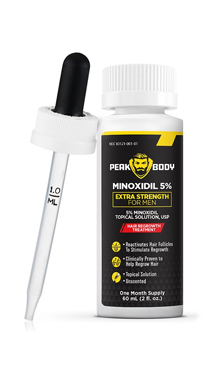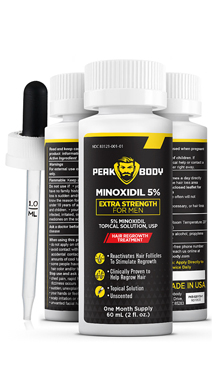Hair Growth
Hair Growth for Men
PeakBody hair growth supplements developed specifically for men to encourage healthy hair growth and overall hair wellness....
Hair Growth for Women
PeakBody hair growth supplements developed specifically for women to encourage healthy hair growth and overall hair wellness....
Minoxidil 1 Pack
Minoxidil 5% Topical Solution extra strength for hair growth treatment. -Reactivates hair follicles to stimulate regrowth. -Clinical...
Minoxidil 3 Pack
Minoxidil 5% Topical Solution extra strength for hair growth treatment. -Reactivates hair follicles to stimulate regrowth. -Clinical...
Hair Restoration
Information and Hair Restoration Treatment Options
Thinning hair, or alopecia, can be caused by heredity, certain medications, medical disorders, nutrition, and environmental factors. Losing 50 to 100 hairs per day is perfectly normal, but some people experience excessive hair loss that results in bald patches or overall thinning of the hair. Approximately 50% of all people, both men and women, experience hair loss by age 50 and can benefit from some type of hair restoration treatment.
Although hair loss does not necessarily indicate the presence of a medical condition, the resulting change in appearance can affect self esteem and cause significant anxiety and distress. Fortunately, there are treatment options for hair loss that can slow its progression and, in some cases, regrow lost hair.
- Now You Can Buy Name Brand, Prescription Medications Online!
- Prescribed to You by Licensed U.S. Physicians Shipped by U.S. Pharmacies
- No Time Off Work
- No Appointment to Schedule
- No In-Office Doctor Co-Pay
Prescription Medication for Male Hair Restoration Prescribed Online from eDrugStore.com
PROPECIA
Propecia targets hairloss on the vertex (top) and anterior mid-scalp area (middle front) of the head, preventing hair loss or stimulates hair re-growth in 90% of men. BUY NOW
FINASTERIDE
Finasteride is a bioequivalent generic version of propecia being the more affordable solution to treat male pattern baldness and prostatic hyperplasia, (enlarged prostate). BUY NOW
Alopecia "thinning hair" Symptoms
The symptoms of alopecia depend on what type hair loss you have. Hair loss can happen rapidly or gradually, all over your scalp or only in one area. Some types of hair loss are temporary, while other types are permanent.
Signs and symptoms of thinning hair include:
- Gradual thinning of hair. Both men and women experience this type of hair loss, but the signs are different for each gender. Hair loss in men tends to start at the hairline and recede backwards to form an ďM?shape. Women typically retain their original hairline, but experience overall thinning on the top of their heads.
- Sudden hair loss. Physical or emotional stress can cause rapid and sudden hair loss. When this happens, the hair will typically come out in clumps when itís washed or combed.
- Full-body hair loss. This type of hair loss happens as a result of certain conditions and medical treatments, such as chemotherapy for cancer.
Alopecia "thinning hair" Causes
The most frequent cause of hair loss is a hereditary condition known as androgenic alopecia, commonly known as male pattern baldness or female pattern baldness. This type of hair loss is triggered by hormonal changes that cause hair follicles to shrink over time. Each hair becomes shorter and finer, until eventually, the affected follicles do not produce new hair.
Other factors and conditions can cause alopecia including:
- Lack of nutrition
- Certain medical conditions
- Taking certain medications
- Physical or emotional stress
- Hormonal changes or thyroid problems
- Damage from certain hairstyles, treatments, or dyes
See your doctor if you are losing hair rapidly, in atypical patterns, or if you are experiencing pain or itching associated with hair loss.
Telogen Effluvium
Telogen Effluvium is the second most common type of hair loss. Itís triggered by emotional or physiological stress that causes a disruption in the normal hair cycle. Common causes include eating disorders, fever, childbirth, chronic illness, surgery, anemia, and severe emotional disorders. It appears as diffuse thinning of hair on the scalp. Once the cause is determined and removed, this condition is fully reversible.
Alopecia Areata
Alopecia areata is an autoimmune disease where the immune system attacks hair follicles, causing bald patches to develop on the scalp, beard, and eyebrows. If the underlying problem is resolved, hair will grow back. After many years, the hair will usually resume growth without treatment. However, in some extreme cases, the disease can cause total hair loss on the head, face, and body.
Diagnosing Alopecia "thinning hair"
A complete medical history and physical examination can help your doctor determine the cause of your hair loss. The diagnosis is typically based on the pattern of hair loss and the presence of accompanying symptoms. Androgenic alopecia can usually be diagnosed based on a physical examination alone.
However, since hair loss can also be a symptom of a medical condition, your doctor might choose to perform a blood test or a skin biopsy to rule out other disorders. This is especially true if you are losing hair in patches, or if you have hair loss along with redness, itching, or pain.
Hair restoration treatments
Treatment options for hair loss depend on your diagnosis. If your hair loss is a symptom of an underlying condition, growth will resume naturally once that condition is resolved. If your hair loss is hereditary, medication or surgery can prevent more hair loss and potentially regrow some hair.
Propecia (Finasteride) is an FDA approved medication that treats male pattern baldness. It interferes with the production of the male hormone linked to hair loss and has been shown to slow the rate of progression. After using Propecia for 12 months, some men may also experience new hair growth on the top of the head. Propecia is the only medication approved for the treatment of androgenic alopecia.
Other treatment options for alopecia include wigs and hairpieces, which can be used to cover both temporary and permanent hair loss. Shaved heads have become popular among men because it gives them a masculine and confident appearance.
Surgical hair restoration
Hair transplant surgery is another popular treatment for thinning hair. In this procedure, tiny plugs of skin from the back of the head are moved to the bald sections of the scalp. Several treatments are usually necessary, as hair loss progresses with time, but this treatment is generally very effective.
During scalp reduction surgery, part of the scalp is removed and replaced with scalp that contains hair. Alternatively, instead of completely removing portions of the scalp, doctors can also choose to cover the bald portions with sections that contain hair.
Though hair transplant surgery is typically effective, it can be very expensive and sometimes painful. Possible risks include infection and permanent scarring.
Hair Growth and your health
See your doctor if you are noticing unusual hair loss since thinning hair might be a sign of a serious medical illness. Hair loss may be brought on by hormonal imbalances, thyroid issues, and/or certain drugs. Ask your doctor about other options if you think a certain medicine is to blame for your thinning hair.
Your entire health may be reflected in the state of your hair. Hair loss can be brought on by excessive weight loss, low iron levels, a bad diet, and stress. A nutritionally balanced diet that contains lean protein, fruits, vegetables, and other foods high in vitamins and minerals will help you maintain healthy, thick, and glossy hair.






